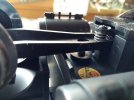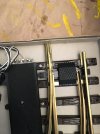Trying to simulate this problem of the LGB Mikado derailing, I removed the point motor of one of my facing points.
The loco ran for over an hour without derailing. But.......
Watching the throw bar I could see that sometimes it would start to move when the 4th driver was nearing the pivot of the point blade. The trailing truck was just before the start of the point blade. The point blade only moved a fraction, less than a millimetre and didn't cause a derailing problem.
Running the loco at a faster speeds there was less chance of movement of the throw bar.
Running at a slow speed was more likely to move the throw bar. (Wish that I knew how to upload videos)
I checked the back to back on the loco and all axles were 40 mm.
Stopping the loco just before the point and then sliding it forwards (this loco will not roll) caused the point blades to separate massively.
The reason that the point blades move is due to the 4th driver axle moving sideways as it nears the pivot point of the point blade.
I can only see 2 possible reasons that the 4th axle moves sideways -
- The lead truck is entering a curve immediately after the point and is starting to turn the loco chassis.
- The traction tires on the 4th axle are slightly smaller diameter than the actual wheel diameter. The traction tires on this loco are getting old now and have perhaps worn down.
- The significance of the traction tires is that there is effectively a groove in the 4th drivers. the groove gets caught by the rail head and the larger diameter of the outer wheel edge drags the point blade across.
I shall obtain some new traction tires.
Is this only a problem with the LGB Mikado?
The timing and crucial thing is that the trailing truck hits the point blade just after the 4th driver has moved the blades. Unusually long distance between the two.
I was interested to see if there was an issue with fully floating point blades, with no motor or over-center spring for control as I ran a reversing loop with with an uncontrolled point for many years without any problems.
These switches are older LGB R1 and R3 models with motor drives
Do you have problems with several switches? Can all of them be problematic?
This is why I was looking at the Mikado.
You need to check that your switches are all throwing correctly.
I seem to remember that one of the issues with the LGB Mikado is the pivoting drive chassis that has a tendency not to fully straighten out on the straights
That's why I suggested lubricating the chassis pivot points and all it's sliding surfaces. If the chassis is not straightening it may be adding to the tendency that I discovered today.
Alan


